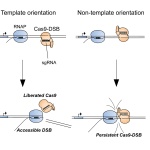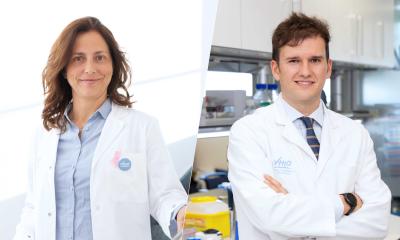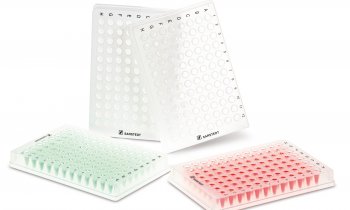Source: Shutterstock/Sergey Nivens
Video • Personalized treatment
Genome analytics become affordable for daily hospital use
Today, on the occasion of the international DNA day, imec, a world-leading research and innovation hub in nanoelectronics and digital technologies, and its partners revealed their Genome Analytics Platform (GAP) platform, a unique platform that can perform a full genome analysis of 48 samples in only 48 hours and at an acceptable cost.
The platform paves the way to genome sequencing as a daily practice in hospitals, for diagnosing and treating genetic diseases, including cancer and rare diseases, and for better treating newborns with complex disorders. Beginning of 2000, when the first human genome was published, the scientific community agreed that they, together with the industry, had to set a goal - the ‘1,000 dollar genome’. They believed that when sequencing the genome would only cost 1,000 USD, it would become feasible to sequence the genome of every patient that needed it for a better, personalized treatment.
Recommended article

Article • Genetics
Sequencing methods – unfold the full potential for hospitals
“We are facing a technological revolution, but we still struggle with actually implementing these new technologies in healthcare institutions”: Professor Jacob Moran-Gilad, MD, MPH, speaks about the gap between the potential of new generation sequencing methods such as WGS and the clinical reality where these technologies have not yet arrived.
Enabling big data, analytics and machine learning innovations are helping today’s medical research be more predictive, productive and personal
Phil Bullinger
Today, this 1,000-dollar genome is almost a reality. However, it becomes clear that just cost-efficient sequencing is not the whole answer to realizing personalized medicine. Turning the raw sequencing data into ‘knowledge’ and useful information for doctors, requires a lot of compute and storage power. Previously, the analysis and storage of the genome data had been too expensive and could take up to several weeks.
Researchers and industry leaders in Belgium have now tackled this genome analytics challenge, making whole genome sequencing process cost- and time-effective for hospitals – not only for research purposes, but also for the treatment of patients in everyday care. The platform consists of a combined compute cluster and ActiveScale cloud object storage system from Western Digital, which runs a heavily optimized genomics software platform and that can also tap into the cloud as needed (BlueBee Genomics Platform). This solution can process the full output of a sequencing machine (48 genomes) within 48 hours, the same time it takes the sequencing machine to produce the raw genome data. “This Genome Analysis Platform project is one of several medical research initiatives Western Digital is supporting in the field of genomic analysis and precision medicine diagnoses at scale,” said Phil Bullinger, SVP Data Center Systems. “Enabling big data, analytics and machine learning innovations are helping today’s medical research be more predictive, productive and personal. It humbles us to be a part of such important and potentially life-saving initiatives.”
Scalable to 63PB (raw) in a single namespace, and up to 19 nines of data durability, Western Digital’s ActiveScale system provides the capacity, data durability and scaling capabilities required to accomplish imec’s extreme data-driven GAP goals – now and into the future. Its unified data access enables the project architects to streamline the interaction between ActiveScale and the process for ingesting and analyzing the massive amounts of genome data. Western Digital NVMe SSDs sustain the velocity of data required to support the processing power of the compute cluster for balanced system design.
Up until now, there was no real ecosystem or workflow available for clinical genomics, and discussions were ongoing on whether local or cloud computing were the best answer. With this new platform, a hybrid solution, combines the best of both worlds: cost-effective analysis at a local site, and faster analysis involving cloud computing.
Recommended article

News • Gene editing
Why CRISPR fails sometimes – and what to do about it
CRISPR has recently become synonymous with precise genetic editing. However, the mighty tool has been known to fail from time to time. Now, researchers have found out why.
One of the project partners, Agilent, has already integrated the hybrid platform solution into a first product – Alissa OnePGT solution – which is being tested by the University Hospital of Leuven (UZ Leuven) and the Human Genetics Group of KU Leuven, to better treat patients. “Sequencing the whole genome of patients is important in case of rare diseases – we treat some 1,000 patients every year – and for newborns when decisions have to be made about their treatment. If you can have a full picture of what is going on in the newborns body (by having a full genome map, and indication of genome abnormalities) better decisions can be made on the treatment. The same goes for prenatal surgery,” explains Joris Vermeesch from the Human Genetics Group. “In the future, when genome sequencing and analysis becomes even more cost-effective and fast, it is even thinkable that a whole genome analysis is performed for every patient.”
“Indeed, this hybrid platform is a major step for the diagnosis and treatment of rare diseases,” says Yves Moreau, from STADIUS - KU Leuven. “In this context, it is important to mention that our Genome Analysis Platform was made compatible with the WINGS platform, a platform that can compare data from patients from different hospitals, without revealing the patient’s identity. For rare diseases, this is the key to a successful diagnosis.” Roel Wuyts, head of imec’s ExaScience Life Lab adds: “For now, the interface developed by Agilent, based on the data from cloud and local computing, needs to be analyzed by specialized doctors. However, in the future it is thinkable that artificial intelligence can help with the interpretation of the dataset and to report the ‘lessons’ from your whole genome sequencing and analysis to your doctor. Your doctor can then discuss the main messages and possible treatments with you. This whole cycle, from sample over sequencing to treatment options should be possible in only few hours.”
Source: imec
25.04.2019











